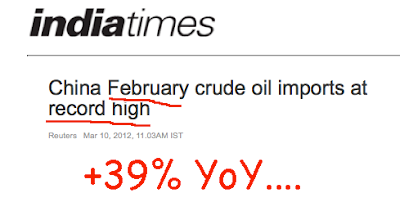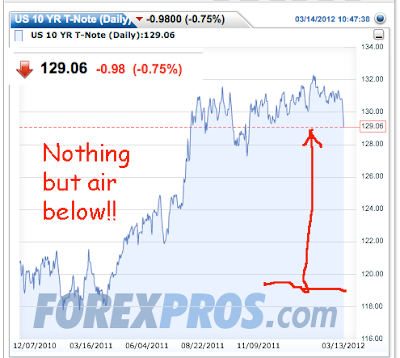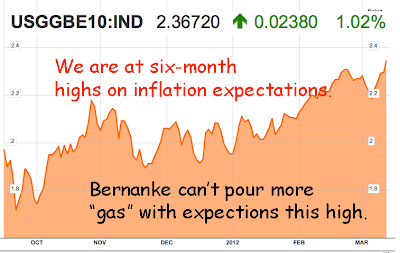Is the Ten-Year going to 3%?
Courtesy of Bruce Krasting
These two articles point in a bad direction:
.
.
China’s 2011 total trade surplus was $183B. The surplus with the USA was $270B; the US was 150% of China’s total surplus. China imports lots of “stuff.” Crude oil is high on that list. Increased domestic consumption, plus additional imports for strategic storage, have pushed up imports to 6 million barrels per day in February. At that rate, the 2012 import bill for crude will be $250B, approximately equal to the US trade deficit with China.
The US/China trade deficit is creating USD surpluses for China’s largest crude suppliers, Saudi Arabia. Angola and Iran are the largest providers. These countries are not America’s friends, and they already have too many dollars. When Americans shop at Wal-Mart, they are actually sending dollars to Iran. In 2012, it will come to about $25B of “our” money that ends up with the Ayatollahs. Welcome to the global village.
 As a result of the shrinking trade surplus and the need to import expensive crude, China does not have the investable dollars it once had. So it is no longer buying US Treasuries at the previous fast pace.
As a result of the shrinking trade surplus and the need to import expensive crude, China does not have the investable dollars it once had. So it is no longer buying US Treasuries at the previous fast pace.
At the same time, the US Treasury is issuing debt at the rate of $100B a month. If the Chinese aren’t buying debt, then it must be sold to other dollar holders.
Saudi Arabia may end up with more dollars in reserves as a result, but I don’t think it will buy long-term bonds with this money. The money will stay in short-term securities. The Saudis will look at the 0.5% they can get on their money for 3-years (or the 5-year at 1%) and just say “no.”
Let's return to the Bloomberg story and the seven-fold increase in bank holdings of Treasury paper:
Commercial lenders purchased $78.2 billion of Treasuries and securities of agencies in January and February, compared with $62.6 billion in all of 2011, bringing their holdings to $1.78 trillion, Fed data show.
It is a financial “unnatural act” when an A- rated bank can extend credit to a AA+ borrower and still make money in the process. This reverse credit arbitrage is made possible by the banks' willingness to "borrow short and lend long." The banks are doing it today because they have unlimited quantities of liquidity available to them through the repo markets at near zero cost. They are playing the carry trade. In the process, they are loading up their balance sheets with low yielding assets, and they are taking risks of rising rates. There is a limit to this.
As of this morning, many of those US financials that own the $1.8T of bonds are not so happy. The strong stock market, better economy and rising inflation expectations have clobbered the bonds the past few days. Some may think that the ten-year at 2.20% is a “buy”. But all I see in this chart is the “air” under the current price.
.
Not surprisingly, inflation expectations have picked up:
.
The easy answer to this conundrum is that the Fed will just keep buying more bonds to keep rates artificially low. I say it can’t do that. If the Fed announced tomorrow that it was going to “TWIST” the market to keep the ten-year at 2%, crude would rise to $150 in a month. Bernanke understands that.
Absent a new move by the Fed to contain long-term interest rates, the ten-year looks like it is headed to 3%. The Chinese are not buying, the banks are full up with paper (and underwater), PIMCO et al are long duration up the wazoo, and any thought that retail interest in five-year bonds at 1% will save the day is just misguided (dumb money is not that dumb).
Bernanke must be delighted today. His strategy all along has been to inflate the S&P and let rising asset values stimulate economic growth. His unlimited supply of cheap money has worked. But it has stoked inflation and that is now being transmitted to the bond market.
I think something has to give, either stocks back off and the economy cools, or the ten-year is headed to 3%. Bernanke can’t have it both ways. He’s about to learn that lesson.
.










